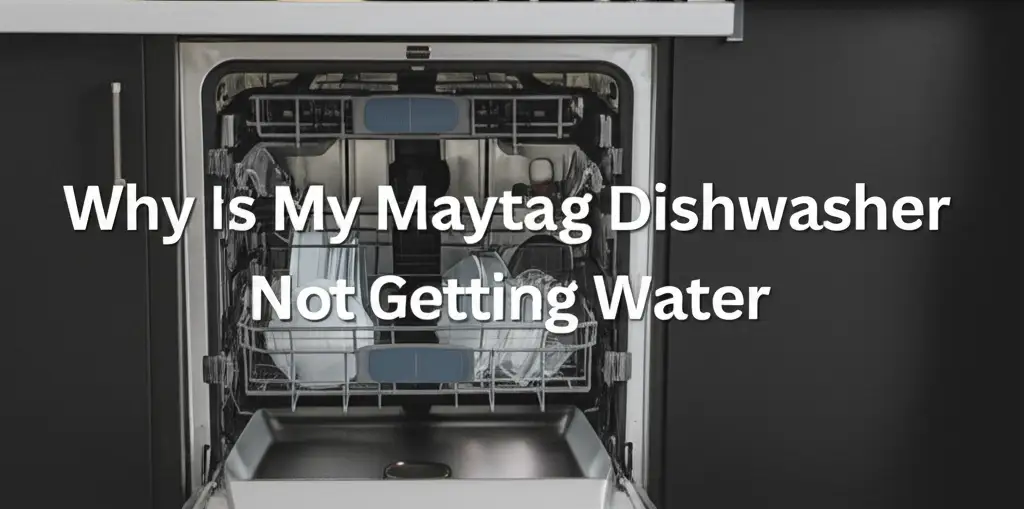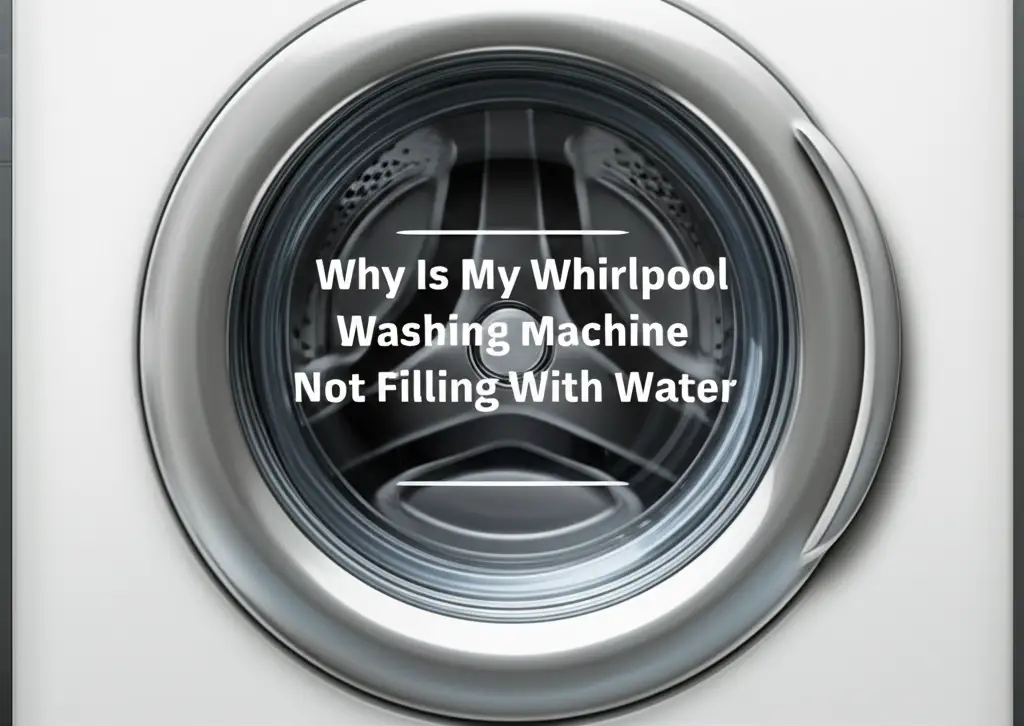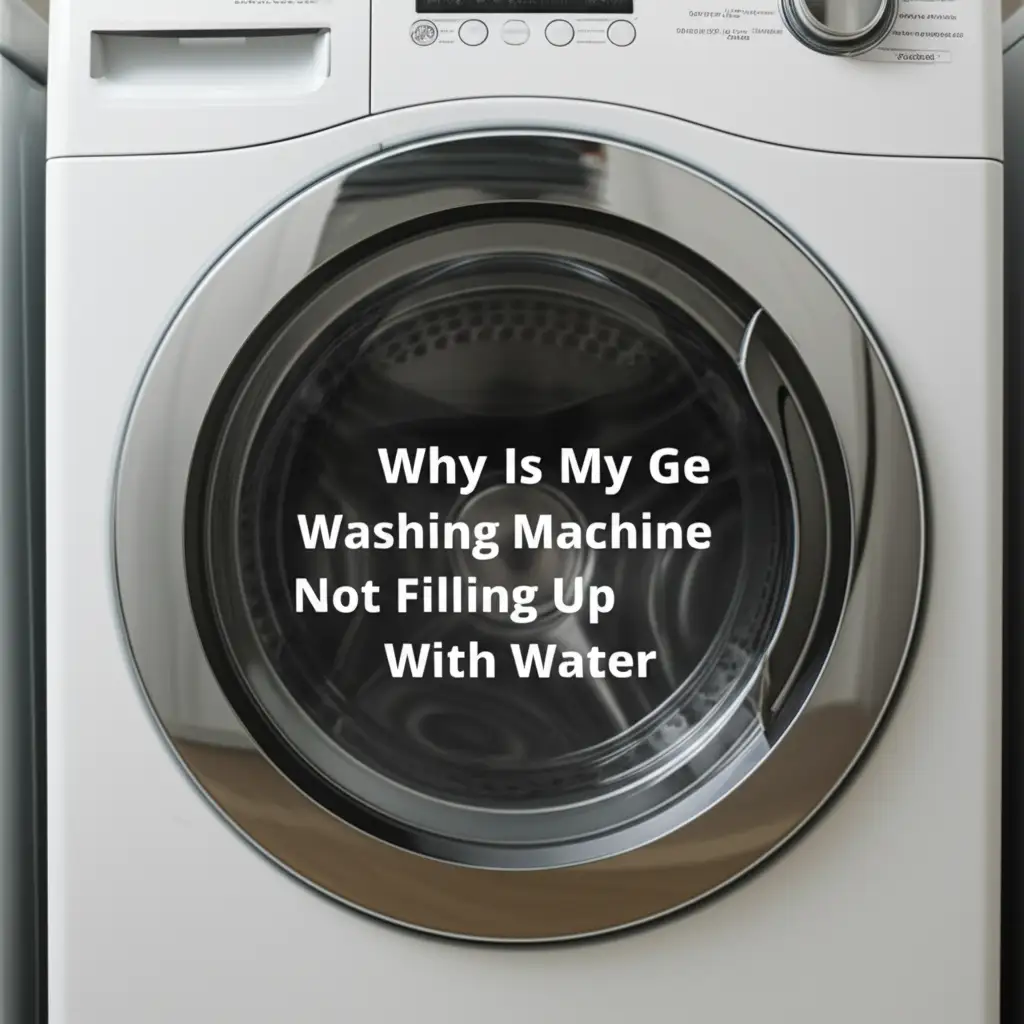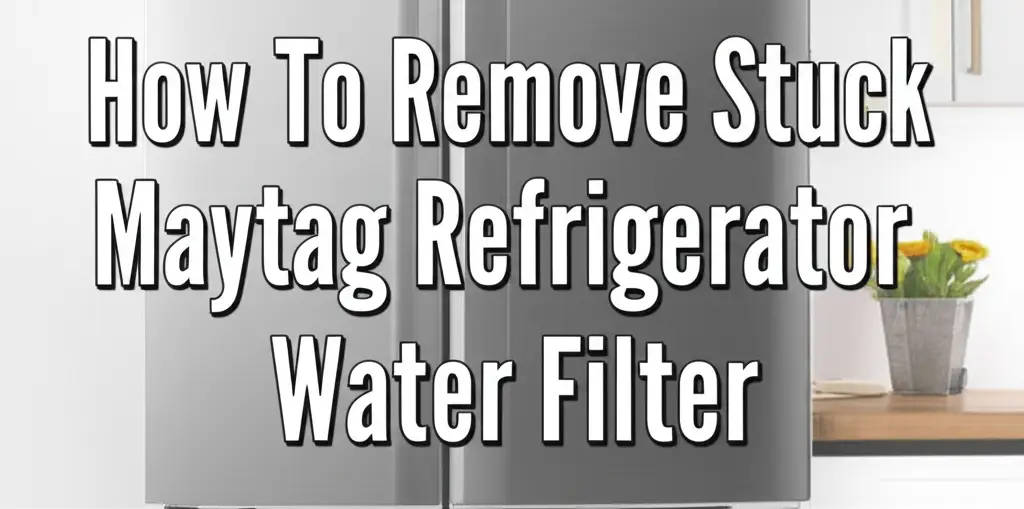· Katria Melrose · Appliance Repair · 16 min read
Why Is My Maytag Dishwasher Not Getting Water

Troubleshooting Your Maytag Dishwasher: No Water?
It is incredibly frustrating when your Maytag dishwasher does not get water. You load the dishes, add soap, press start, and then hear nothing, or perhaps just a hum. A dishwasher needs water to clean your dishes, so this problem stops the cleaning cycle completely. I understand this common appliance issue can disrupt your kitchen routine and leave you with a sink full of dirty dishes. You want answers, and you want your dishwasher working again.
This article will help you understand why your Maytag dishwasher might not get water. We will explore the most common causes, from simple checks you can do yourself to more complex component failures. I will provide clear, step-by-step guidance to help you diagnose and fix the problem. By the end, you will have a clear path to getting your dishwasher to fill with water and clean dishes once more.
Takeaway
- Check Water Supply: Ensure the water valve is open and there are no kinks in the supply hose.
- Inspect Water Inlet Valve: This valve often fails, preventing water entry.
- Test Float Switch: A stuck or faulty float switch stops the fill cycle.
- Verify Door Latch/Switch: The dishwasher needs the door securely closed to start filling.
- Clear Clogs: Debris in filters or spray arms can affect water flow and sensing.
- Examine Drain System: A clogged drain can prevent the dishwasher from filling.
- Consider Control Board: Electronic issues may cause fill problems.
Your Maytag dishwasher might not get water due to issues with its water supply, a faulty water inlet valve, a stuck float switch, a broken door latch or switch, or a clog in the drain system. Less common causes include a problem with the main control board or wiring.
Initial Checks and Water Supply Issues
When your Maytag dishwasher does not get water, the first step is always to check the basics. Sometimes, the problem is not with the appliance itself but with the external water supply. This can save you time and money. I always start here before looking at any internal components.
First, locate the water supply valve for your dishwasher. This valve is typically under the kitchen sink, near where the dishwasher’s water line connects to the house plumbing. Make sure this valve is fully open. If it is closed, no water can reach your dishwasher. Turning it clockwise closes it, and counter-clockwise opens it. Ensure it is turned as far counter-clockwise as possible.
Next, examine the water supply hose. This hose connects the dishwasher to the water supply valve. Look for any visible kinks or bends in the hose. A severe kink can restrict water flow, preventing the dishwasher from filling. Straighten any kinks you find. Also, check for any signs of damage or leaks. A damaged hose might not allow water to flow properly.
It is also wise to check your home’s main water supply. If you have low water pressure or no water in other parts of your house, the issue is not just with the dishwasher. A general plumbing problem or a temporary municipal water outage can stop your dishwasher from getting water. Test a nearby faucet to see if water flows normally. If water pressure is low throughout your home, contact a plumber or your water utility company. My Maytag dishwasher did not get water once because the main water line had a problem. This simple check can save you a lot of troubleshooting time.
Diagnosing a Faulty Water Inlet Valve
A common reason a Maytag dishwasher does not get water is a problem with the water inlet valve. This component is crucial for allowing water into the dishwasher tub. It is an electrically operated valve that opens when the control board signals it to fill. When it fails, water cannot enter the machine. I often find this part is the primary culprit when water fill issues occur.
The water inlet valve is typically located at the bottom front of the dishwasher, behind the lower access panel. It connects to the main water supply line and the fill tube inside the dishwasher. Over time, sediment or mineral deposits from hard water can clog this valve. This prevents it from opening fully or closing properly. A restricted valve will not allow enough water into the dishwasher, or it might not allow any water at all.
You can often hear a buzzing sound from the dishwasher when it tries to fill. If you hear this buzzing but no water enters, it strongly suggests a faulty water inlet valve. To test the valve, you need to access it. First, disconnect power to the dishwasher. Then, carefully remove the lower access panel. You will see the valve where the water line connects. Disconnect the electrical connectors and the water lines. Test the valve’s solenoid for continuity with a multimeter. If there is no continuity, the valve is bad and needs replacement.
Sometimes, the screen filter on the inlet valve gets clogged. This filter catches debris from the water supply, protecting the valve. If this screen is full of gunk, water cannot pass through. You can carefully remove the screen and clean it. If cleaning does not solve the problem, or if the valve itself is faulty, replacing the entire water inlet valve is necessary. This part is critical for allowing your Maytag dishwasher to fill with water. If your Maytag dishwasher won’t fill with water, this valve is a prime suspect.
Inspecting the Float Switch Assembly
The float switch is another vital component when your Maytag dishwasher does not get water. This small device prevents the dishwasher from overfilling. It consists of a plastic float cup at the bottom of the tub and a switch assembly underneath. As water fills the tub, the float rises. When it reaches a certain level, it activates the switch, which tells the control board to stop the water flow. If this system malfunctions, the dishwasher may not start filling or may stop filling prematurely.
A common issue is the float becoming stuck in the “up” position. This can happen due to food debris, detergent residue, or other foreign objects getting lodged underneath it. If the float is stuck up, the dishwasher’s control board “thinks” the tub is already full of water. Therefore, it will not allow any new water to enter. To check this, open the dishwasher door and look at the bottom of the tub. You will see a small plastic cup or cylinder, usually near the front. Try gently pushing it down and releasing it. It should move freely up and down. If it feels stiff or does not spring back, it might be stuck.
To properly inspect the float switch, you might need to remove the lower spray arm and the filter assembly. This provides better access to the float. Clean around the float assembly thoroughly, removing any debris or buildup. Ensure it can move without obstruction. If the float moves freely but the dishwasher still does not get water, the switch itself might be faulty.
The float switch is typically a simple two-wire switch. You can test it with a multimeter for continuity when it is in the “down” (empty) position. If the switch does not show continuity when it should, it needs replacement. A faulty float switch tricks the dishwasher into believing it is full, preventing any water from entering the wash cycle.
Addressing Door Latch and Switch Issues
Your Maytag dishwasher relies on a fully closed and latched door to begin any cycle, including filling with water. This is a safety feature designed to prevent leaks and accidents. If the door latch is not engaging properly, or if the door switch is faulty, the dishwasher will not get water. It simply will not recognize that it is safe to start the cycle. I always make sure the door is firmly closed when troubleshooting a “no water” issue.
First, check the door latch itself. Look for any visible damage to the latch mechanism on the dishwasher door and the strike plate on the dishwasher tub. Over time, plastic latches can wear out or break. Sometimes, a piece of food or debris can get stuck in the latch, preventing it from fully closing. Ensure nothing is obstructing the latch. Give the door a firm push when closing it. You should hear a distinct click, indicating it has latched correctly.
Even if the door latches, the problem might be with the door switch. This switch is located inside the dishwasher frame, near the latch mechanism. It senses whether the door is properly closed and latched. If the switch is defective, it will not send the “closed” signal to the control board, even if the door is physically shut. The dishwasher’s control system will then refuse to initiate the water fill cycle.
Testing the door switch requires accessing it, which usually means removing the inner door panel or the console panel. Disconnect power to the dishwasher before you start. Once you access the switch, you can test it for continuity using a multimeter. With the door open, the switch should show no continuity. When the door is closed and latched, it should show continuity. If it does not, the switch is faulty and needs replacement. A broken door latch or a defective door switch is a common reason why your Maytag dishwasher will not get water.
Clogged Internal Components and Water Flow
While directly stopping water from entering, clogged internal components can mimic the symptom of a Maytag dishwasher not getting water. If water enters the tub but quickly drains, or if water is present but not distributed, it can appear as a fill problem. Sometimes, the dishwasher tries to fill, but the water cannot circulate properly, leading to error messages or incomplete cycles. This also affects how well your dishwasher cleans. If your Maytag dishwasher is not cleaning dishes properly, this could be a related cause.
The main internal components to check for clogs are the filters and the spray arms. Dishwashers have a filter system, usually at the bottom of the tub, that catches food particles and debris. If this filter becomes heavily clogged, it can restrict water flow to the wash pump. This can prevent water from reaching the spray arms effectively, making it seem like the dishwasher is not filling adequately or not distributing water throughout the tub. Remove the filter assembly and clean it thoroughly under running water. Use a brush to scrub away any stuck-on debris.
Next, inspect the spray arms. Maytag dishwashers typically have upper and lower spray arms (and sometimes a middle one). These arms have small holes that spray water during the wash cycle. Over time, these holes can become clogged with food particles, mineral deposits, or even pieces of plastic from dishware. If the spray arm holes are blocked, water pressure drops, and water cannot be effectively sprayed onto dishes. This can make the dishwasher appear to not have enough water, or it may impact the wash performance significantly, leading to issues like your Maytag dishwasher not getting dishes clean.
To check the spray arms, carefully remove them (they usually unscrew or unclip). Use a toothpick or a thin wire to clear any debris from the spray holes. Run water through the spray arms in a sink to ensure all holes are clear. Reinstall the cleaned components. Ensuring these parts are clear ensures proper water circulation once water has entered the tub.
Investigating Drain System Issues
It might seem counterintuitive, but a problem with your dishwasher’s drain system can sometimes prevent it from getting water. Most dishwashers have a safety feature that will not allow new water to enter the tub if it detects that the tub is already full, or if the drain system is blocked. This prevents overflow. If your Maytag dishwasher does not get water, checking the drain system is a logical step.
First, check for standing water in the bottom of your dishwasher tub. If there is water, it means the drain pump or drain hose is clogged or malfunctioning. The dishwasher will not initiate a new fill cycle if water is already present in the tub. You will need to manually remove the standing water first. Use a towel or a wet/dry vacuum to clear the water.
Next, inspect the drain filter and drain pump area for obstructions. Food particles, broken glass, or other debris can accumulate in these areas, blocking the drain pump impeller or the filter itself. You usually access this by removing the lower spray arm and the filter assembly at the bottom of the tub. Carefully remove any visible debris. Some models have a pump cover that needs to be unscrewed to fully access the impeller. Be cautious of any sharp objects.
The drain hose is another potential source of a clog. This hose connects your dishwasher to your sink’s drain or garbage disposal. Food particles can get stuck in the hose, especially where it connects to the garbage disposal. Disconnect the drain hose from the garbage disposal or sink drain and check for blockages. You may need to use a snake or a straightened coat hanger to clear the hose. Ensure the drain hose has a proper high loop. This loop prevents dirty water from the sink from flowing back into the dishwasher and helps with proper drainage. Without a high loop, the dishwasher may not drain completely, tricking the machine into thinking it is full.
Control Board and Advanced Electrical Problems
When your Maytag dishwasher does not get water and all other mechanical checks have failed, the problem might lie with the control board or other electrical components. The control board is the “brain” of your dishwasher. It sends signals to all other parts, including the water inlet valve, telling them when to activate. If this board malfunctions, it might not send the correct signal for water to enter, or it might receive incorrect signals from other sensors.
Diagnosing a control board issue is more complex and often requires professional help. However, there are a few basic things you can check. First, look for any signs of power issues. Does the display light up? Do other functions seem to work? If the dishwasher seems completely dead, it could be a power supply issue, a tripped breaker, or a blown fuse. Check your home’s circuit breaker box to ensure the breaker for the dishwasher has not tripped. Reset it if necessary.
Sometimes, a simple reset can resolve a temporary glitch with the control board. You can often reset a Maytag dishwasher by disconnecting its power for a few minutes. Unplug the dishwasher from the wall outlet or flip the circuit breaker off for 5-10 minutes, then restore power. This can clear minor errors that might prevent the water fill cycle from starting.
If the control board itself is faulty, you might see specific error codes displayed on the dishwasher’s control panel. Refer to your Maytag dishwasher’s user manual to interpret these codes. Some codes directly relate to water supply or fill issues. A flickering or blank display, or unresponsive buttons, can also indicate a failing control board. Replacing a control board is typically an expensive repair. This is often the last step in diagnosing a Maytag dishwasher that does not get water, after ruling out all other common issues.
Frequently Asked Questions
Why is my Maytag dishwasher humming but not filling with water?
If your Maytag dishwasher hums but does not fill with water, the most likely culprit is a faulty water inlet valve. The humming sound indicates the valve’s solenoid is trying to open, but it is either clogged or defective. Check your water supply valve first, then consider replacing the water inlet valve.
How do I reset my Maytag dishwasher if it’s not getting water?
To reset your Maytag dishwasher, try unplugging it from the wall outlet. Alternatively, flip the circuit breaker that supplies power to the dishwasher off for 5-10 minutes, then turn it back on. This hard reset can clear temporary electronic glitches that prevent water from entering.
Can low water pressure prevent my Maytag dishwasher from filling?
Yes, low water pressure can definitely prevent your Maytag dishwasher from filling properly. Dishwashers require a certain minimum water pressure to operate. Check if other faucets in your home have low pressure. If so, the issue is with your home’s plumbing or main water supply, not just the dishwasher.
Where is the water inlet valve on a Maytag dishwasher?
The water inlet valve on most Maytag dishwashers is located at the bottom front of the appliance. You can usually access it by removing the lower access panel or kick plate, which is typically held in place by a few screws. It is where your home’s main water line connects to the dishwasher.
What is the role of the float switch in a dishwasher not getting water?
The float switch prevents overfilling. If the float gets stuck in the “up” position, or if the switch itself is faulty, the dishwasher’s control board will think the tub is already full. This prevents the water inlet valve from opening, stopping any new water from entering the dishwasher.
How much does it cost to fix a Maytag dishwasher that is not getting water?
The cost to fix a Maytag dishwasher not getting water varies based on the part. A water inlet valve or float switch typically costs $30-$100 for the part itself. Professional labor can add $100-$300. Control board replacements are more expensive, sometimes $200-$400 for the part, plus labor.
Conclusion
It can be incredibly frustrating when your Maytag dishwasher does not get water. This problem brings your kitchen routine to a halt. We have explored the most common causes, from simple water supply issues to more complex component failures like a faulty water inlet valve or control board. By systematically checking each potential culprit, you can often pinpoint the exact reason why your dishwasher is not filling.
Remember to always start with the easiest checks, like ensuring the water supply valve is open and the hose is not kinked. Then, move on to the water inlet valve, float switch, and door latch. Cleaning clogged filters and checking the drain system are also crucial steps. Most of these checks and some minor repairs are well within the capabilities of a homeowner. If the issue persists after these steps, or if you suspect an electrical problem, consider contacting a qualified appliance technician. With patience and these troubleshooting steps, you can get your Maytag dishwasher to fill with water and clean dishes again.
- Maytag dishwasher
- dishwasher no water
- appliance troubleshooting
- Maytag repair
- water inlet valve
- dishwasher fill issue
- home appliance





